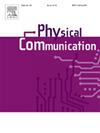Cooperative sensing performance of multi-satellite uplink systems
IF 2
4区 计算机科学
Q3 ENGINEERING, ELECTRICAL & ELECTRONIC
引用次数: 0
Abstract
As global communication needs continue to grow, the scarcity of spectrum resources and the increase in interference underscore the importance of cognitive satellite communication systems. However, existing research has notable shortcomings in addressing uplink multi-satellite cooperative sensing performance in highly dynamic scenarios, particularly regarding multi-node cooperative detection performance while considering factors such as attenuation. Furthermore, there is a lack of in-depth discussion concerning analysis and fusion strategy design. To address these challenges, this paper proposes a method that combines Monte Carlo simulation with theoretical analysis, taking into account signal attenuation, distance uncertainty, and noise uncertainty, to conduct a comprehensive study of uplink multi-satellite cooperative sensing performance. Specifically, we employed soft fusion technology using Square Law Combining (SLC) and hard fusion technology utilizing various rules and conducted simulation experiments. The research results indicate that different fusion methods can both enhance and diminish signal detection performance. The analysis and simulation results presented in this paper validate the effectiveness of the proposed method, offering significant references for the selection and design of multi-node cooperative detection strategies across various scenarios involving low Earth orbit satellite constellations.
多卫星上行系统协同传感性能研究
随着全球通信需求的不断增长,频谱资源的稀缺和干扰的增加凸显了认知卫星通信系统的重要性。然而,现有研究在解决高动态场景下上行多星协同感知性能方面存在明显不足,特别是在考虑衰减等因素的情况下,多节点协同检测性能的研究存在明显不足。此外,缺乏对分析和融合策略设计的深入讨论。针对这些挑战,本文提出一种蒙特卡罗仿真与理论分析相结合的方法,考虑信号衰减、距离不确定性和噪声不确定性,对上行多星协同传感性能进行综合研究。具体来说,我们采用了基于平方律组合(SLC)的软融合技术和基于多种规则的硬融合技术,并进行了仿真实验。研究结果表明,不同的融合方法对信号检测性能既有提高的作用,也有降低的作用。分析和仿真结果验证了所提方法的有效性,为低轨道卫星星座各种场景下多节点协同探测策略的选择和设计提供了重要参考。
本文章由计算机程序翻译,如有差异,请以英文原文为准。
求助全文
约1分钟内获得全文
求助全文
来源期刊

Physical Communication
ENGINEERING, ELECTRICAL & ELECTRONICTELECO-TELECOMMUNICATIONS
CiteScore
5.00
自引率
9.10%
发文量
212
审稿时长
55 days
期刊介绍:
PHYCOM: Physical Communication is an international and archival journal providing complete coverage of all topics of interest to those involved in all aspects of physical layer communications. Theoretical research contributions presenting new techniques, concepts or analyses, applied contributions reporting on experiences and experiments, and tutorials are published.
Topics of interest include but are not limited to:
Physical layer issues of Wireless Local Area Networks, WiMAX, Wireless Mesh Networks, Sensor and Ad Hoc Networks, PCS Systems; Radio access protocols and algorithms for the physical layer; Spread Spectrum Communications; Channel Modeling; Detection and Estimation; Modulation and Coding; Multiplexing and Carrier Techniques; Broadband Wireless Communications; Wireless Personal Communications; Multi-user Detection; Signal Separation and Interference rejection: Multimedia Communications over Wireless; DSP Applications to Wireless Systems; Experimental and Prototype Results; Multiple Access Techniques; Space-time Processing; Synchronization Techniques; Error Control Techniques; Cryptography; Software Radios; Tracking; Resource Allocation and Inference Management; Multi-rate and Multi-carrier Communications; Cross layer Design and Optimization; Propagation and Channel Characterization; OFDM Systems; MIMO Systems; Ultra-Wideband Communications; Cognitive Radio System Architectures; Platforms and Hardware Implementations for the Support of Cognitive, Radio Systems; Cognitive Radio Resource Management and Dynamic Spectrum Sharing.
 求助内容:
求助内容: 应助结果提醒方式:
应助结果提醒方式:


